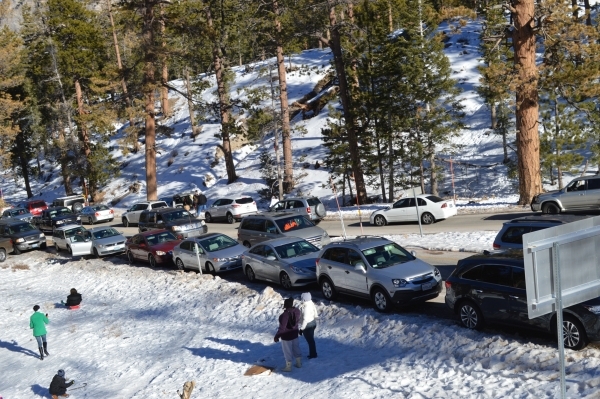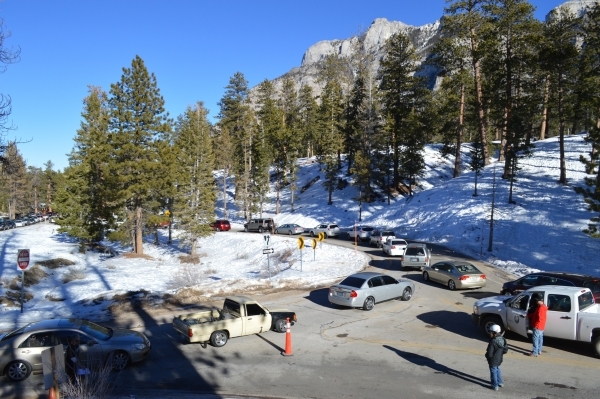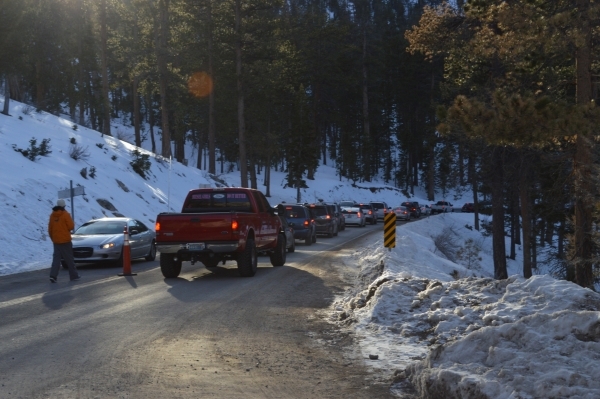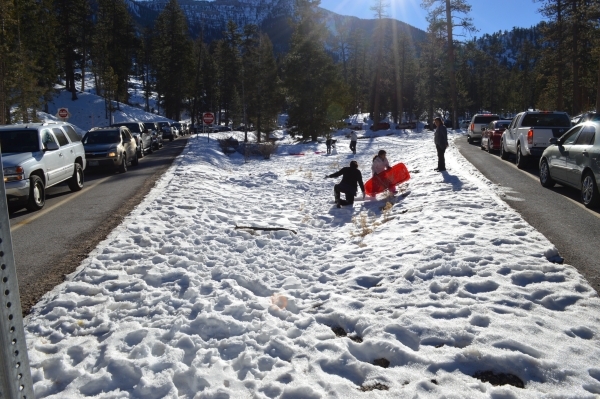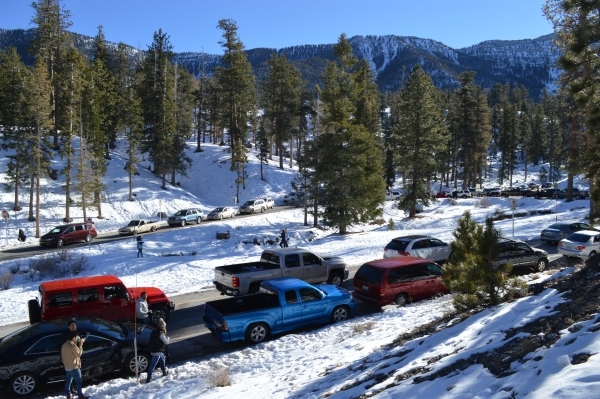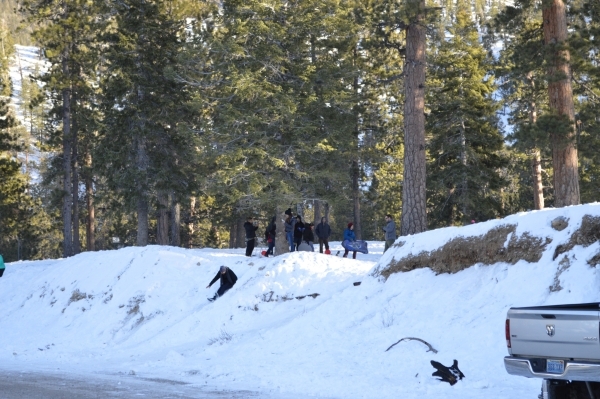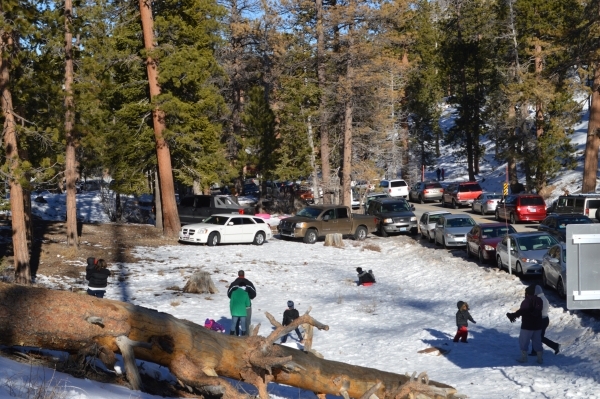Alliance calls attention to winter safety in the mountains
The secret is out.
You can ski and play in the snow within an hour's drive of Las Vegas.
And now that it's no longer a secret, Mount Charleston is subject to the same kinds of things that happen to all popular places — it gets crowded.
Because of the potential for large crowds hoping to spend a weekend skiing, sledding, snowboarding or just playing in a frigid environment most desert dwellers aren't accustomed to, several agencies have banded together to offer tips on trips to higher elevations.
The Mount Charleston Winter Alliance launched a website that provides winter road conditions and weather updates as well as safety tips and pointers for weekend and vacation visitors to Southern Nevada's high country.
The site — www.mtcharlestonwinter.com — provides a list of winter recreation sites within Spring Mountains National Recreation Area, maps and advice aimed at preventing a winter day trip from becoming a disappointment or worse.
"A group of us got together early this spring and said we needed to come up with something to educate the public," said Clark County Commissioner Larry Brown, whose district includes Mount Charleston.
"The mountain is a fragile place and because of all the great investments that have occurred up there by Lee Canyon, it's no longer a secret that we have this so close to home," he said.
Officials estimate that 25,000 people make their way up to the Mount Charleston area on busy weekends and holidays.
Six government entities banded together to provide resources and to develop the coalition's website.
Alliance members are the rural division of the Clark County Fire Department, Mount Charleston Fire and Rescue, Metropolitan Police Department, U.S. Forest Service, Nevada Highway Patrol and Nevada Transportation Department.
Brown said the groups were brought together because they all have oversight of different aspects of safety on the mountain. The alliance and the website will promote public safety, particularly in the winter months when visitation spikes and conditions warrant additional caution.
"Members of this alliance know the mountain inside and out, which is why it's important to listen to their advice on travel there," Brown said.
Trooper Loy Hixson, public information and education officer for the Nevada Public Safety Department, said although officers will assist motorists running into trouble on the mountain, a better plan is for drivers to be prepared before they even set foot in their vehicles.
"There are a few extra things people heading to snow country should take along when they go," Hixson said. "They should take tire chains or a tow strap, a cellphone, a flashlight, an ice scraper, jumper cables, a snow shovel, a blanket or sleeping bag, a first-aid kit, a compass, maps, a bag of sand or kitty litter for traction, spare batteries, nonperishable foods and water."
Hixson warned that cellphone coverage can be spotty on the mountain. One of the useful tips from the website: There's a pay phone located across from Lee Meadows.
Hixson also recommended a trial run for putting on tire chains before going up the mountain to make sure a motorist knows how to do it.
"Make sure your vehicle is properly equipped with gas and fluids," Hixson said. "Some people don't realize there are no services up there. Fill your gas tank before you leave and be sure your radiator has antifreeze. Down here, many people just put water in the radiator. Take it from somebody who lived in Oklahoma, you don't want water in the radiator when it gets below freezing."
And low temperatures are commonplace. Lee Canyon and Kyle Canyon are box canyons with one way in and one way out. Temperatures in Lee Canyon are generally slightly lower than those of Kyle Canyon. According to the website, Saturday's predicted low is 6 below zero with 46 mph winds in Kyle Canyon and 11 below zero with 46 mph winds in Lee Canyon.
Hixson also noted that desert dwellers may also find their bodies aren't acclimated to the higher elevation.
"When you get up above 9,000 feet, the air is thinner and if you aren't in better health, the elevation can tax your heart and your brain," Hixson said.
Contact reporter Richard N. Velotta at rvelotta@reviewjournal.com or 702-477-3893. Find him on Twitter: @RickVelotta
Here are some tips from the Mount Charleston Winter Alliance’s new website promoting safety on winter trips to Kyle Canyon and Lee Canyon:
* Before heading to the Spring Mountains Recreation Area, check for driving conditions, chain requirements and road closures. For real-time road information, dial 511 within Nevada (or 877-NV-ROADS outside of Nevada).
* Use caution while driving in winter storms. Drive slowly and allow for greater braking distances. Accelerate and brake gradually.
* When parking off road, all wheels must be to the right of the white line to allow for emergency vehicles to pass. Illegally parked vehicles are subject to fines and towing. There is no roadside parking on state Route 156 between Lee Meadows and the Lee Canyon ski area. Roadside parking also is prohibited in Kyle Canyon past the intersection of state Routes 157 and 158.
* Lee Canyon is best for skiing and has the largest snow play and recreation area. The Foxtail Picnic Area is ideal for sledding. Lee Meadows is good for sledding, but is crowded on weekends and parking is limited.
* Never play near roads or vehicles. Avoid dangerous objects such as large rocks and trees. Be aware of others so you don't run into them. Don’t sled in an area with less than 12 inches of snow. Don’t play on private land or “closed” areas.
* Public restrooms are located at Foxtail and Sawmill picnic areas, the visitor center or in open campgrounds.



